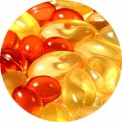Fact: The human body needs to get EPA or DHA omega-3s from foods or supplements
The body can't rely on ALA omega-3s to create EPA and DHA. In order to increase your body's EPA and DHA levels, you need to eat foods containing these nutrients or take supplements. Unfortunately, the typical Western diet includes too little EPA and DHA. Take the quiz to see if you're getting enough.
The amount you need
Although omega-3s are considered vital, recommendations on how much you need vary quite a bit from country to country. Most often the recommendations range from 250-1000 mg per day. Emerging research suggests that upwards of 1000 mg (1 g) of EPA+DHA may be a good daily amount to target.
Test your levels
Not sure if you're getting enough EPA and DHA omega-3s from your diet? Test your levels with a simple at-home blood test. Here are two options to try:
- Omega-3 Index (OmegaQuant)
- Omega3Test (Lipid Labs)
You can get EPA and DHA omega-3s by eating fish, taking a supplement or eating foods made with added EPA and DHA.

A standard serving of fish is about 4 ounces (113 grams) by weight. Fatty fish – for example, salmon, mackerel, herring or tuna – tend to have higher omega-3 content. If you eat fatty fish twice per week, your omega-3 daily average would be about 250-500mg.
Omega-3 Content of Fish
You can also increase the amount of EPA and DHA you get daily by adding an omega-3 supplement.
There are many options to choose from: supplements made from fish, krill or vegetarian marine algae; smaller-sized supplements for easier swallowing; enteric-coated supplements designed to reduce “fish burps;” flavored liquid formulas; and so much more. The key is to find a supplement that you like, and that you’ll stick with.
Remember when you’re looking for a supplement, look at the Supplement Facts panel on the bottle or box, and add up the amounts of EPA and DHA provided in each serving (be sure to check the serving size, too!).
More About Supplements
Foods and beverages with added EPA and DHA can help boost your omega-3s a little bit, but you shouldn't depend on these functional foods for all of your daily EPA and DHA needs. Most foods and drinks have between 30-100 mg added EPA and/or DHA, and your goal should be at least 500 mg.
More About Functional Foods
